This simple yet flavorful Mirin Salmon recipe is a keeper for your weeknight dinners! Just marinate the salmon fillets in mirin and soy sauce for two days, then bake in the oven until crispy on the edges and perfectly moist inside.
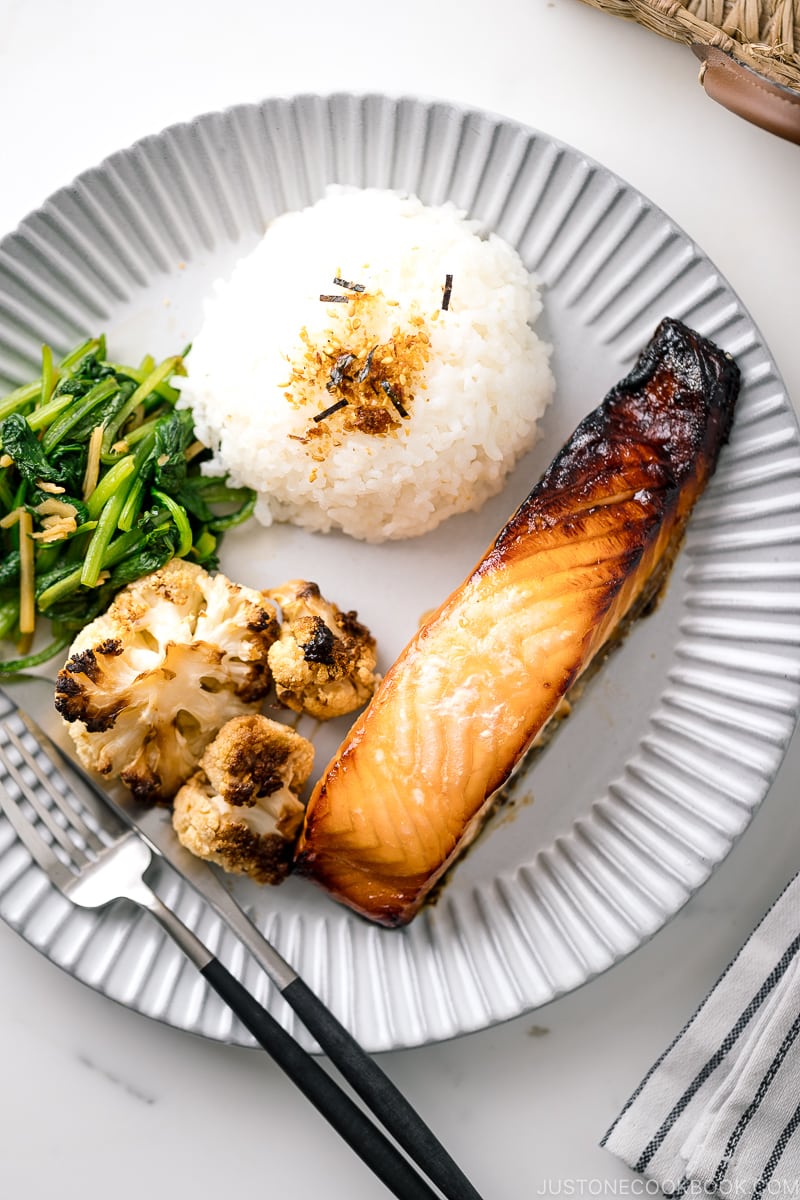
Don’t we all love an easy and quick recipe that feeds the family? Even better if it requires just a few ingredients from the pantry. That’s why I’m excited to share today’s recipe with you!
Mirin Salmon, or what we call Salmon Mirin-zuke in Japan, is a classic dish that utilizes the simple trio of Japanese condiments: sake, mirin, and soy sauce. You are going to love this one, I promise!
What is Mirin-zuke?
Mirin-zuke (味醂漬け) literally means ‘marinated in mirin’. The word ‘zuke’ (pronounced [zukeh], 漬け) means to marinate, and you may have heard of Shoyu-zuke (marinated in soy sauce), Miso-zuke (marinated in miso), Shio-zuke (marinated in salt).
The salmon is marinated in the mixture of mirin and soy sauce. It’s very important to use mirin with higher % of alcohol, and not a mirin-like or mirin-type condiment (read more about different kinds of mirin). More about this topic later.
This Mirin Salmon is not a saucy dish. The flavors are all in the salmon, that’s why you will need to marinate for exactly 2 days.
Ingredients matter when comes to a traditional recipe like this. I hope you get fresh piece of salmon and use quality mirin. The subtle sweetness and flavor of mirin should be notable, so you don’t need to add more soy sauce or sugar.
Why You’ll Love Mirin Salmon
- Quick and easy – Yes, the marinate time is 2 days, but the active “cooking” time is almost zero.
- Minimal ingredients – Salmon, sake, mirin, soy sauce…and that’s it!
- Delicious – Elegant Japanese flavors with a perfect balance of sweet and savory.
- Make ahead – Just prep the salmon by marinading in the refrigerator for exactly 2 days, and then bake in the oven!
- Ideal to feed a crowd – It makes a great choice for an effortlessly fast yet impressive dinner, so make a large batch when you have guests over.
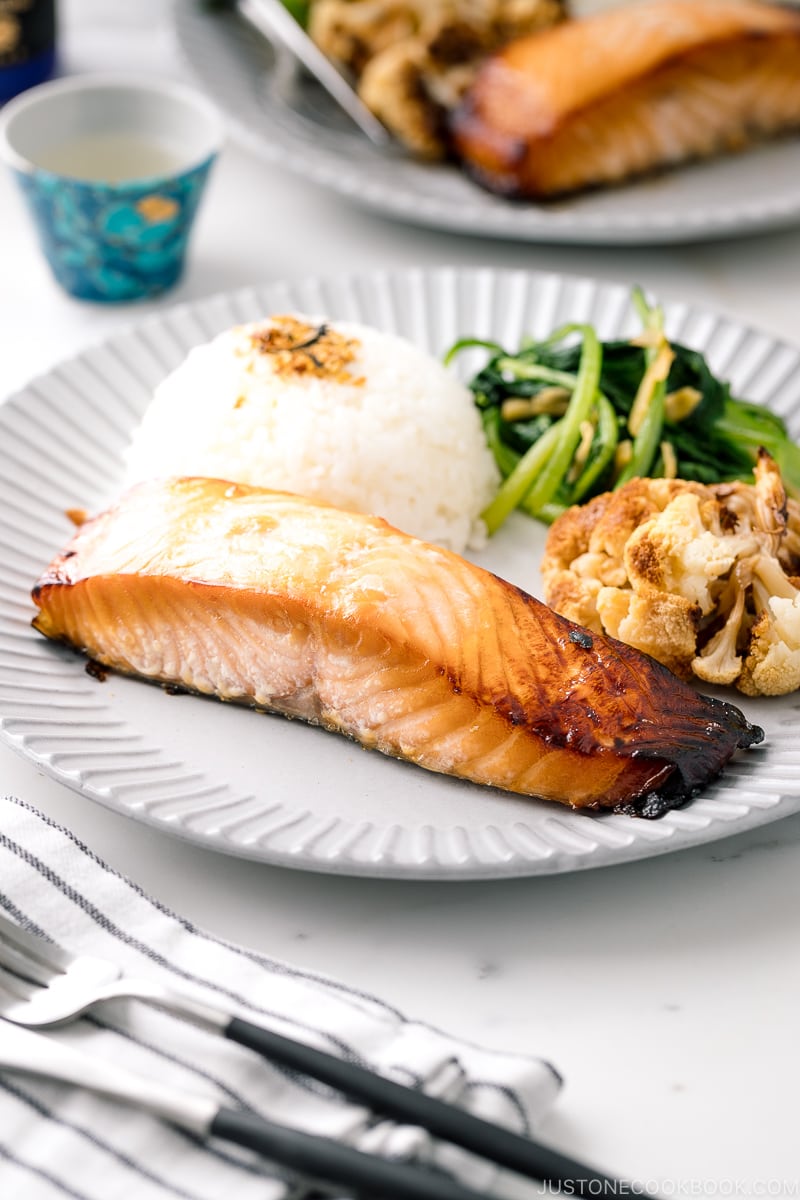
Mirin and Sake I Recommend
As I mentioned earlier, the main ingredient for Mirin-zuke is, obviously, mirin. It’s very important to use mirin with a higher % of alcohol, and not a mirin-like or mirin-type condiment (read more about different kinds of mirin).
Sake is almost always used whenever we make fish recipe. The alcohol masks the fishy smell while imparting a sweet natural umami from the fermented rice wine.
I’ve been using Takara Sake‘s Sho Chiku bai Classic Junmai and Takara Mirin for a long, long time. And I’m glad that I get to partner with the company for several years now to introduce the trusted Japanese ingredients to elevate your cooking!
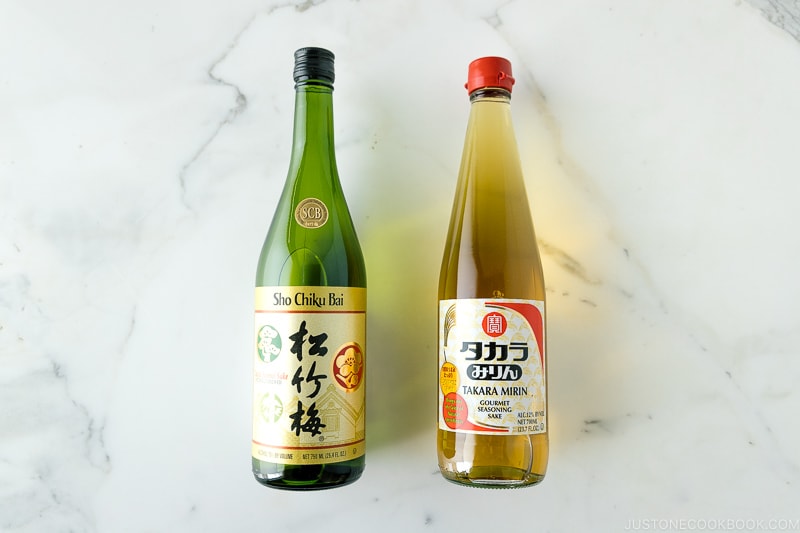
How to Bake Salmon
Baked Salmon seems like a no-brainer, however, it can be tricky to achieve the perfect texture without overcooking or undercooking the fish. Let’s go over some important tips.
- Preheat. Preheat the oven to 425 ºF (218ºC) and place the rack in the middle of the oven. Place the salmon skin-side-down on a parchment paper-covered baking sheet. Let your salmon fillets rest out on the counter for 15-20 minutes until they have come to (almost) room temperature. This will help with even cooking.
- Bake. Bake until the internal temperature of the salmon reaches 145°F (63 ºC), measured with a cooking thermometer in the thickest part of the filet. I use an oven probe thermometer, so the oven will let me know when it’s done cooking, and it takes about 20 minutes, depending on the thickness and temperature of the fillet. You can also test for doneness by inserting a fork or knife in the salmon and twisting it a bit; the fish should be opaque and flake easily.
- Broil. Brush the salmon with remaining marinade and broil for 3 minutes (without changing the oven rack position that is in the middle of the oven). You can also check the doneness of your salmon with a fork. When the salmon flakes easily with a fork, it’s ready.
- Serve. Remove the baking sheet from the oven and transfer the salmon to a serving plate. Here I serve the salmon with steamed rice (with furikake rice seasoning on top), roasted miso garlic cauliflower, and sautéed greens with ginger.
How About Broiling?
Sure you can! Broiling in the oven is basically an inverted grilling, cooking food almost entirely by infrared radiation. Therefore, you have to control the distance between the food and the top heating element, by adjusting the oven rack position.
The thin Japanese salmon cut works well under the broiler as it’s very quick to cook. However, thick-cuts like the fillets I used may take a bit longer time to cook the inside, so you have to be very careful how far you place your salmon. They should not be too close to the heating element, or else they get burned on the outside while the inside is yet to be cooked through.
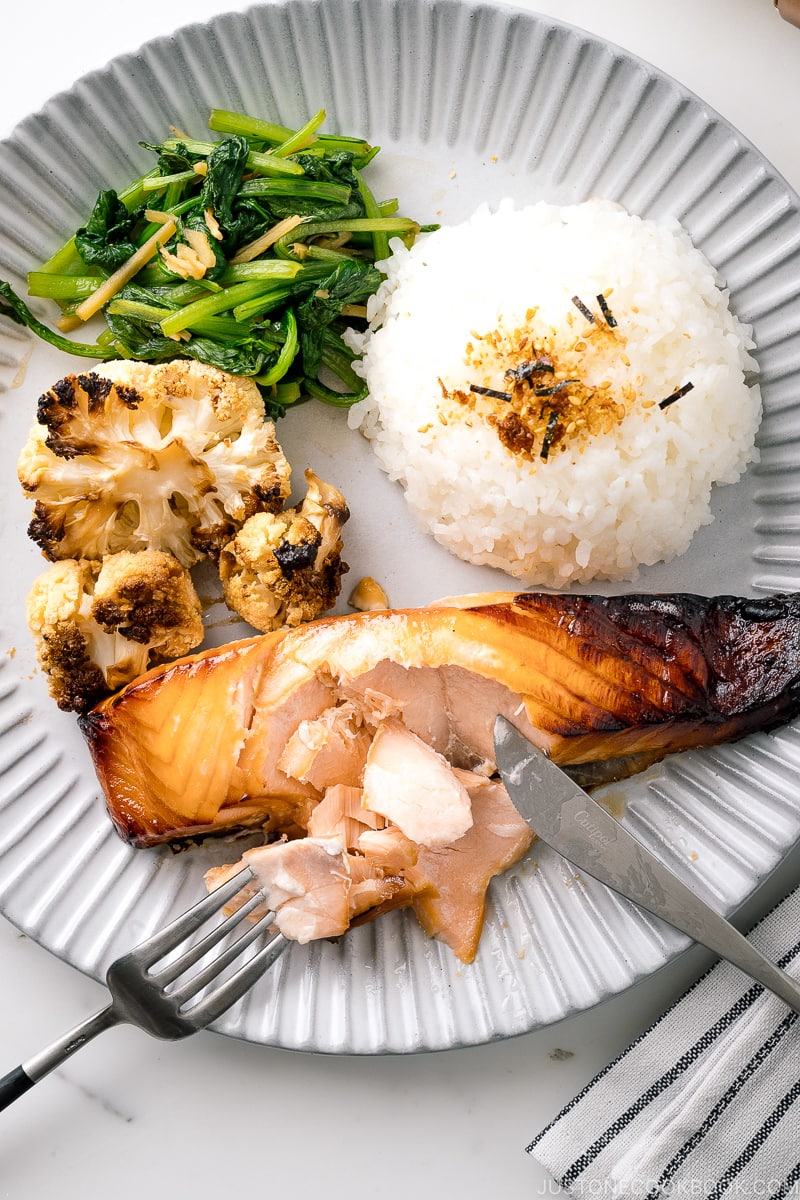
Helpful Cooking Tools
- A resealable bag – I am not a fan of using plastic in general, but I occasionally use it as it is effective in cooking. Some of the pros include:
- You can use a lot less marinade because a small amount of liquid can spread all over the salmon inside the bag.
- When you remove the air from around the salmon, the low pressure causes suction and the marinade reaches the salmon more quickly.
- This opens up the pores of the salmon so it soaks up the flavor rapidly. If you decide not to use a plastic bag, please double the marinade so it will cover the salmon.
- Pre-cut parchment paper – I discovered this “precut” parchment paper from another food blogger years ago and since then, I haven’t gone back to regular parchment paper. There are no more frustrations that the paper is not cut well or the box is broken. It’s a bit more expensive than regular rolled parchment paper, but I find the precut sheets work better for me since I do not waste paper by tearing off too much.
- Oven probe thermometer – No more guessing if the salmon is cooked through (145 ºF or 63 ºC) or not. It tells you exactly when it’s done cooking! I used my Thermador oven’s probe thermometer this time, but I also have and love Thermowork’s ChefAlarm.
- Fish spatula – This stainless steel fish spatula is thin and flexible and it slips smoothly under even delicate food. Since I do not use a non-stick pan, I can freely use this spatula all the time on my carbon steel pans.
What to Serve with Mirin Salmon
If you like to serve a classic Japanese-style meal called Ichiju Sansai (1 soup 3 dishes), here are my suggestions:
- Steamed rice (method: rice cooker, Instant Pot, pot over stovetop, donabe over stovetop)
- Miso Soup
- Sides: Kinpira Gobo (Braised Burdock Root), Chikuwa Isobeage, Chrysanthemum Greens and Tofu Salad (Shungiku Shiraae)
- Pickle: Soy Sauce Pickles, Cabbage Pickles
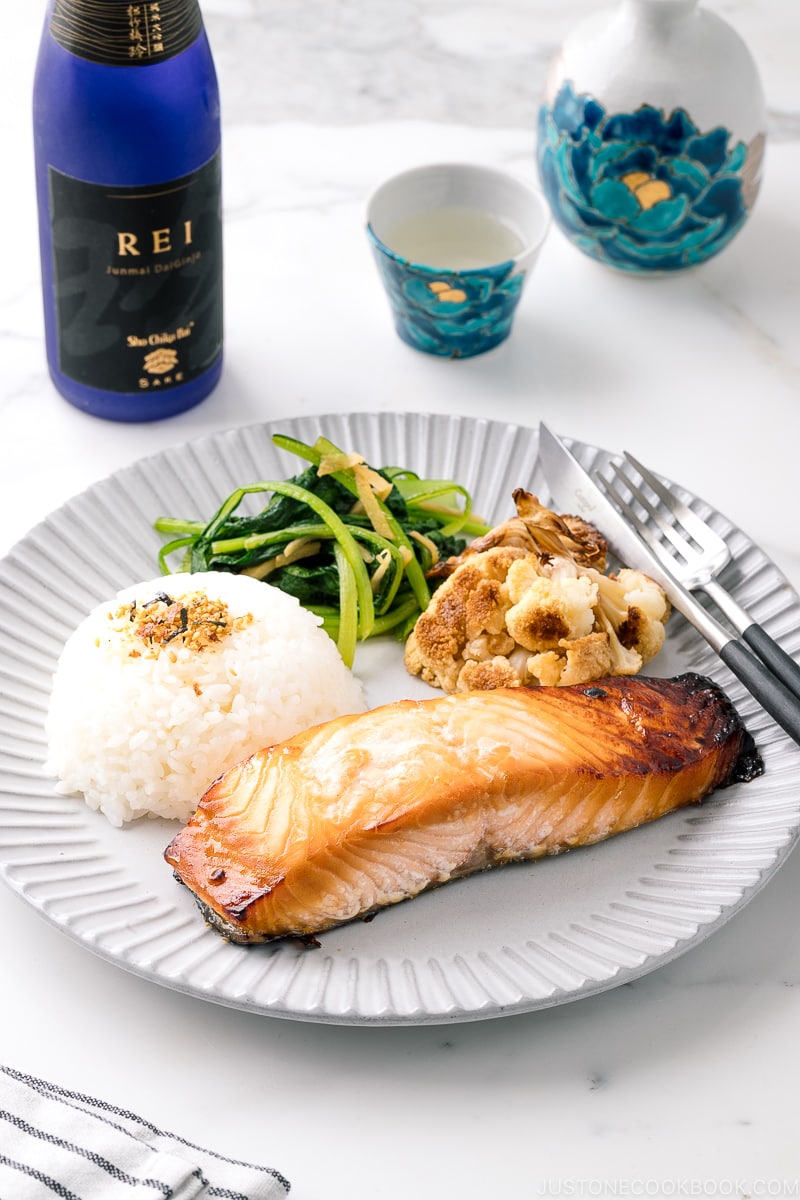
Sake Pairing with Sho Chiku Bai REI Junmai Daiginjo
Takara Sake makes several types of sake that we really like. Depending on the food, we would pair it with different sake. However, if I had to pick one sake to serve guests or to drink myself, it would be Sho Chiku Bai REI Junmai Daiginjo.
REI is a very versatile sake that works with many different types of food. It complements flavorful dishes like this mirin salmon, or yakitori and sukiyaki. Its flavor is delicate and floral with hints of melon and peach. The texture is refined and slightly creamy, with a bit of spice note at the end.
With mirin salmon, REI’s notes are intensified after eating the fish, and creaminess balances out the salmon’s flaky texture. It was simply perfect. We look forward to discovering more dishes that’ll work well with REI.
You can purchase this sake on the Takara Sake website or from your local liquor stores or Japanese grocery stores.
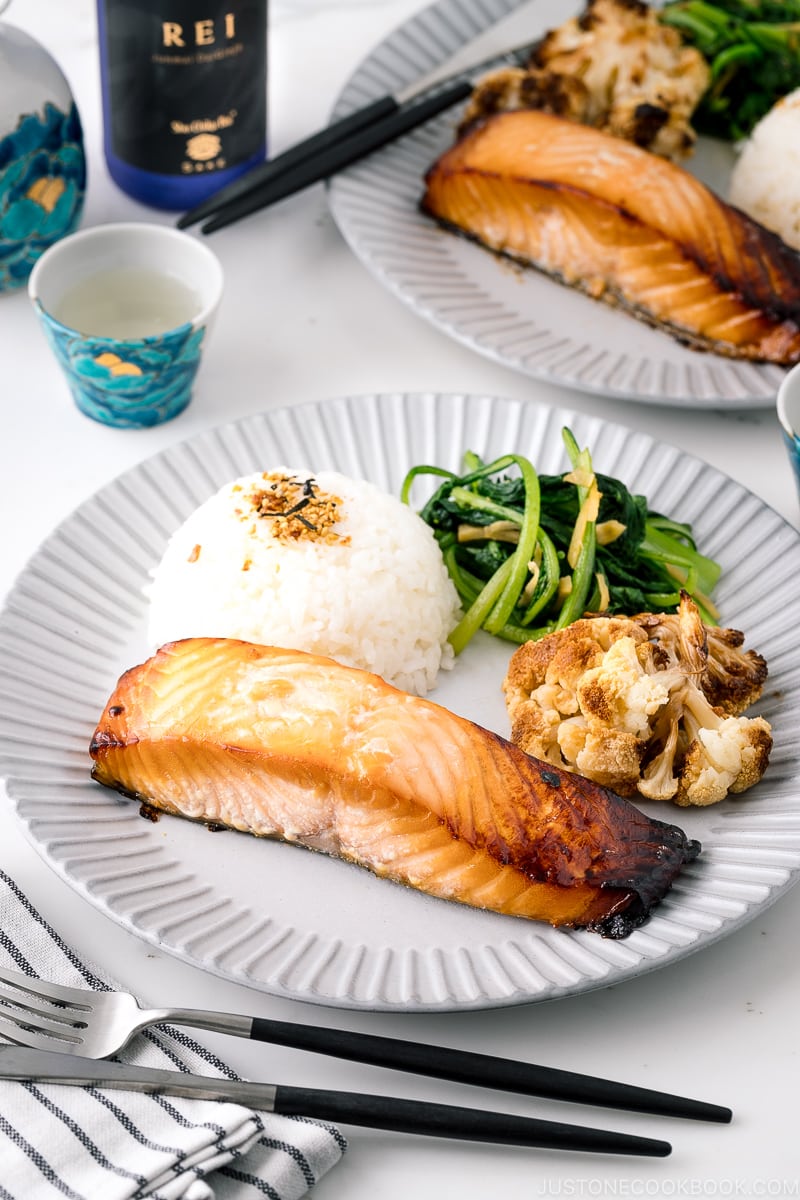
Other Delicious Salmon Recipes on Just One Cookbook
If you enjoy salmon, you should definitely check out the following salmon recipes on my blog!
- Miso Slamon
- Teriyaki Salmon
- Salmon Nanbanzuke (Marinated Fried Salmon)
- Salmon Fried Rice
- Salmon Potato Gratin
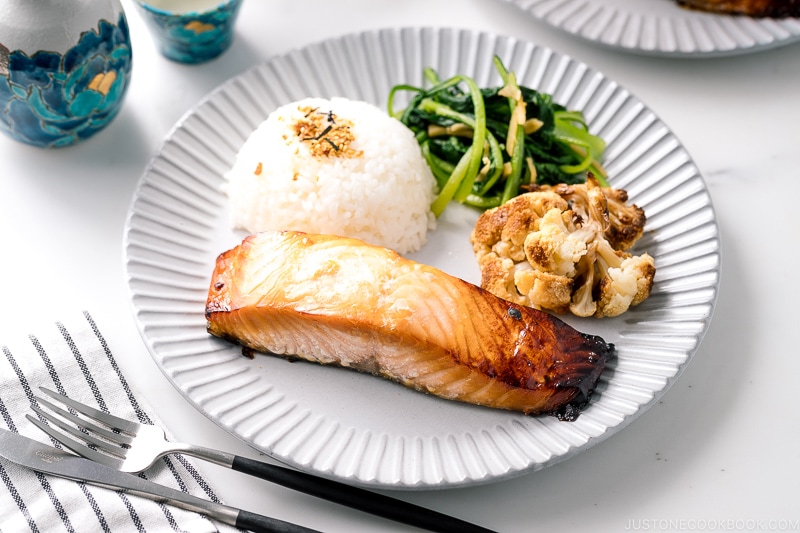
Wish to learn more about Japanese cooking? Sign up for our free newsletter to receive cooking tips & recipe updates! And stay in touch with me on Facebook, Pinterest, YouTube, and Instagram.
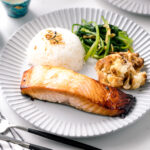
Mirin Salmon
Ingredients
- 4 skin-on salmon fillets (1½ lb, 680 g)
- 1 tsp Diamond Crystal kosher salt
- 1 Tbsp sake (for rinsing off the salt)
Instructions
- Gather all the ingredients.
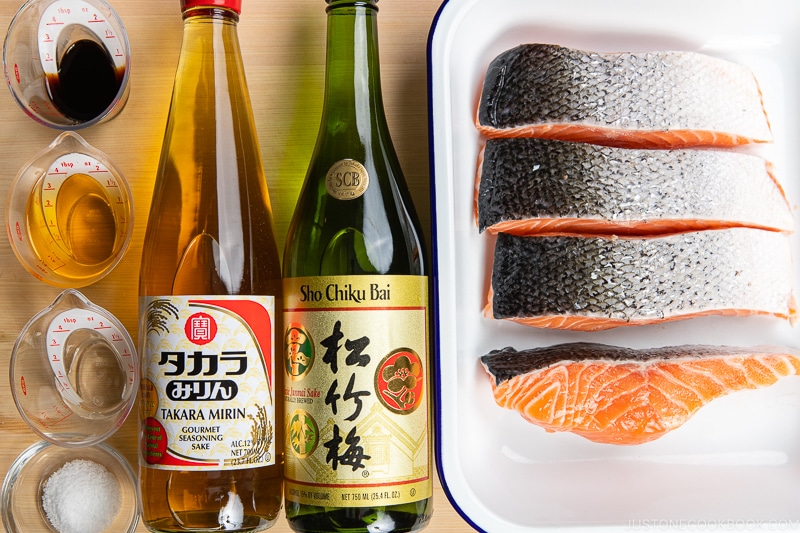
To Marinate the Salmon (for 2 days)
- Sprinkle 1 tsp Diamond Crystal kosher salt all over 4 skin-on salmon fillets and set aside for 15 minutes. Salt draws moisture from the salmon and removes the unwanted fishy smell.
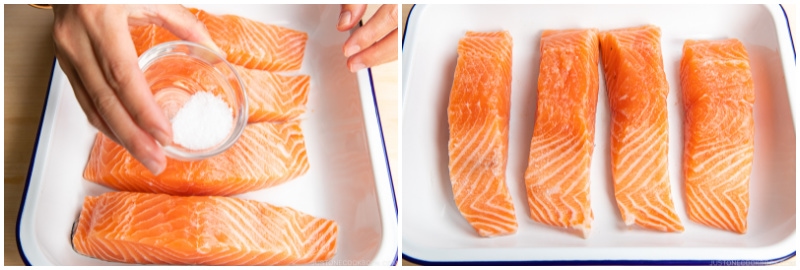
- Combine 4 Tbsp mirin and 1 Tbsp soy sauce in a ziplock bag. I try to reduce the amount of plastic as much as possible, however, there are pros of using a plastic bag here. 1) You can use a lot less marinade because a small amount of liquid can spread all over the salmon inside the bag. 2) When you remove the air from around the salmon, the low pressure causes suction and the marinade reaches the salmon more quickly. 3) This opens up the pores of the salmon so it soaks up the flavor rapidly. If you decide not to use a plastic bag, please double the marinade so it will cover the salmon.
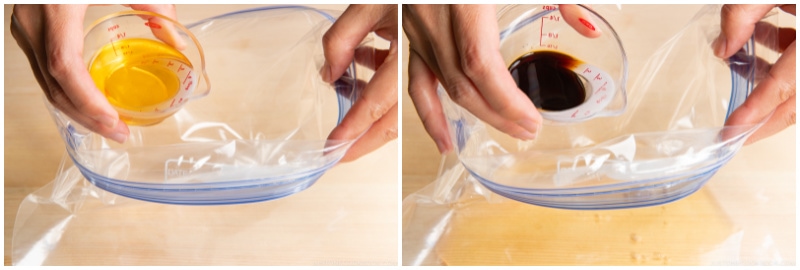
- After 15 minutes, rinse the salt and moisture that come from the salmon with 1 Tbsp sake. Pat the salmon dry with paper towels.
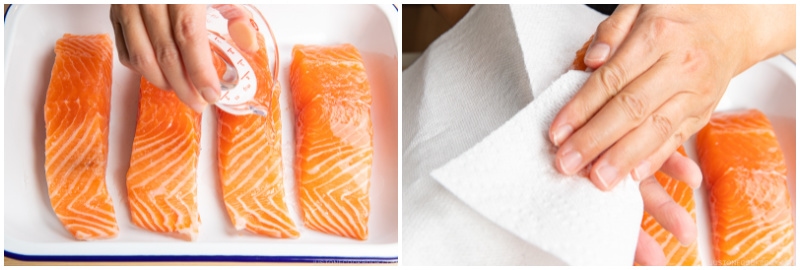
- Put the salmon in the bag with the marinade. Remove as much air as possible and seal the bag. Place in the refrigerator and marinate for exactly 2 days (1 day is too short and 3 days are too long to keep the salmon in the fridge).
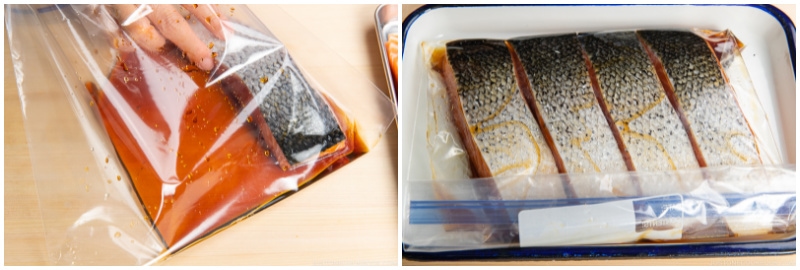
To Bake the Salmon (2 days later)
- Take out the salmon from the refrigerator 15–20 minutes prior to cooking, and let is rest out at the counter until close to room temperature. Meanwhile, preheat the oven to 425ºF (230ºC). For a convection oven, reduce cooking temperature by 25ºF (15ºC). Set the oven rack in the middle, 9 inches (23 cm) away from the top heating element.
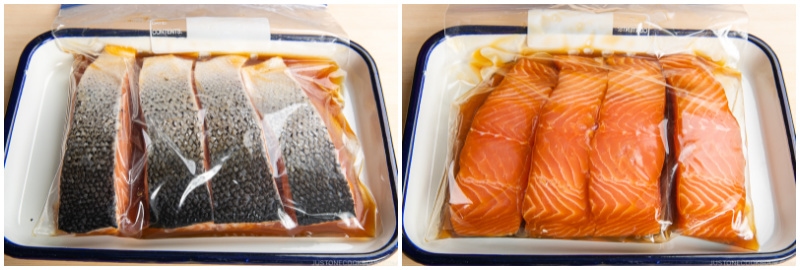
- Transfer the salmon fillets from the bag to the baking sheet lined with parchment paper. Reserve the marinade for later use. I use an oven probe thermometer so the oven will let me know when the salmon reaches 145ºF (63ºC). I love it, no need to use a timer or guess if the salmon is done cooking! I use my Thermador oven‘s probe thermometer this time, but I also have and love Thermowork’s ChefAlarm.
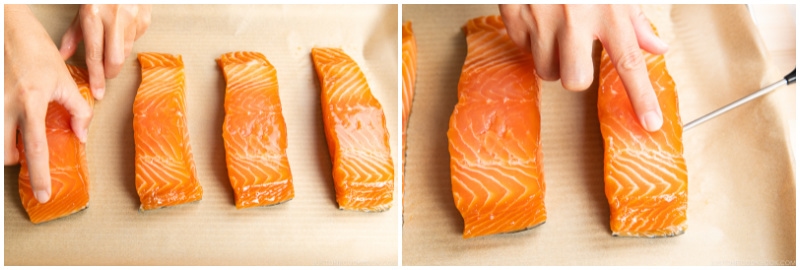
- Bake in the preheated oven for 15–20 minutes, or until the internal temperature of the salmon is 145ºF (63ºC). The cooking time varies depending on the size and temperature of the salmon. You can also test for doneness by inserting a fork or knife in the salmon and twisting it a bit; the fish should be opaque and flake easily.
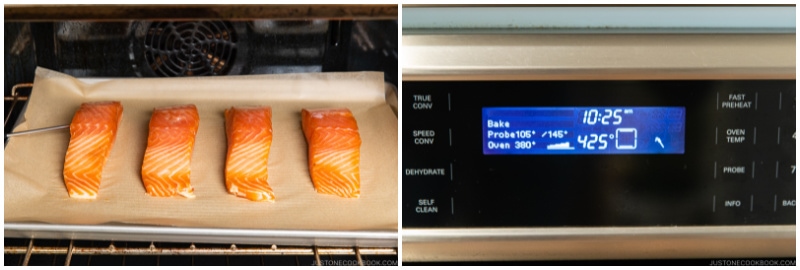
- Remove the baking sheet out of the oven and change to a broiler setting. Keep the middle rack position.
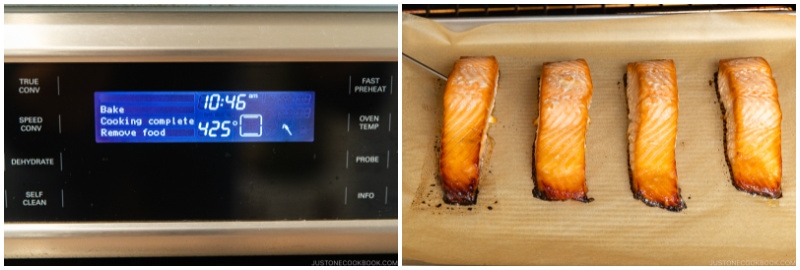
- Transfer the reserved marinade to a bowl and brush the marinade over the salmon fillets.
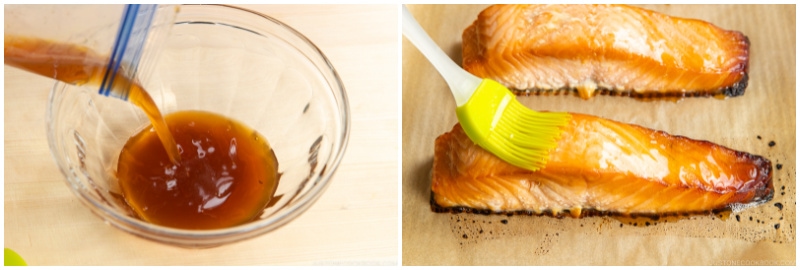
- Put the baking sheet back to the preheated broiler and broil for 2–3 minutes, until nicely charred. Personally, I think the charred salmon tastes better, even though it might not look the best. If you go for the taste, I recommend adding more char to the salmon (just like the color of the bottom part of the fillet in the picture).
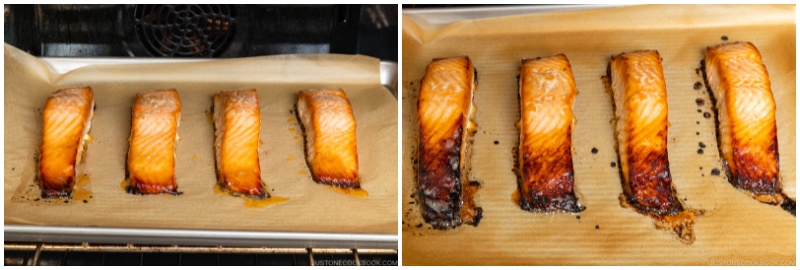
To Serve
- Serve the salmon fillet with side dishes. Here, I served the salmon with steamed rice with furikake rice seasoning, sautéed greens with ginger, and roasted miso garlic cauliflower.
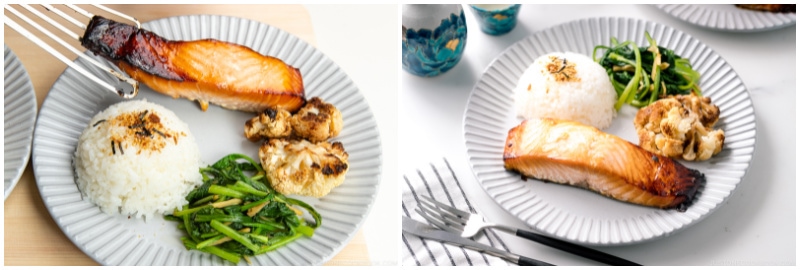
To Store
- You can keep the leftovers in an airtight container and store them in the refrigerator for 2 days or in the freezer for a month.
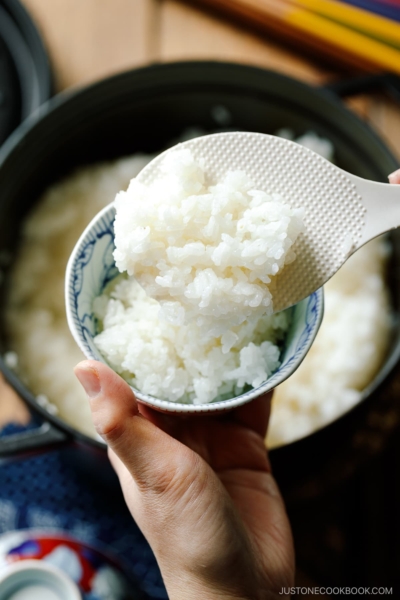
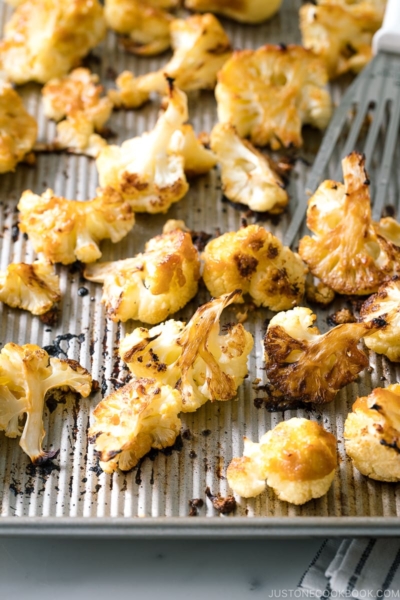
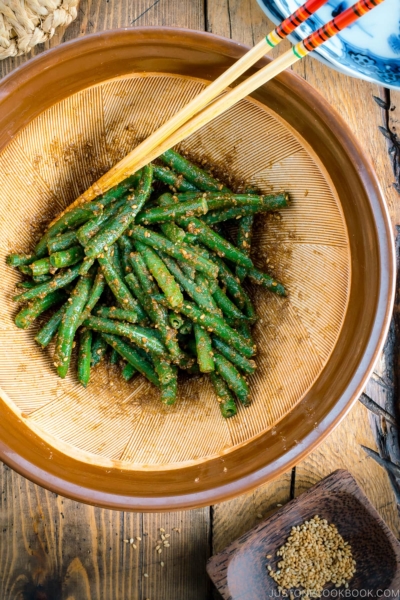
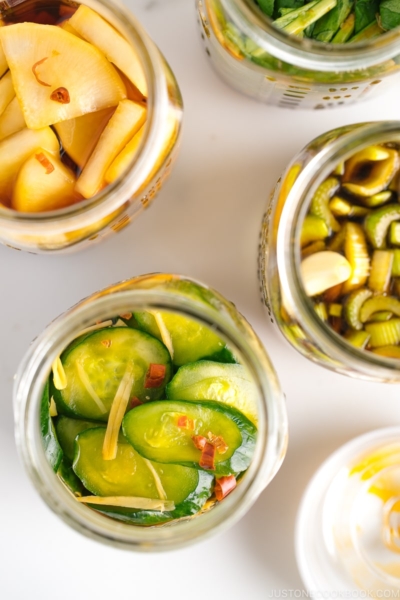




Can I freeze it after 2 days of marinating?
Hi Jacek! Yes. You may freeze them. 🙂
Thank you for reading Nami’s post and trying her recipe!
This was absolutely delicious! I cooked this and served it with rice, the green beans gomaae, and the roasted miso cauliflower, also from your site. We loved it!
Hi Ashley! Thank you so much for trying Nami’s recipes and for your kind feedback!
We are glad to hear you enjoyed many recipes from our site.
Thank you for cooking with Nami!🤗
this is my go-to salmon recipe! flavorful enough to eat on its own with rice but also neutral enough that it can be flaked into a salad, formed into a rice ball and honestly eaten cold out of the Tupperware as a snack. i will often make 2 lbs at a time and have it the whole week for dinner after work.
Hi Jason! Thank you very much for trying Nami’s recipe and for your kind feedback!
We are so happy to hear this recipe worked very well for you to plan your dinner for a week! Happy Cooking!
Dear Nami…found it 😀
🙂
Dear Nami, we hope this finds you well! My daughter and I are learning to make this delightful salmon dish. In your ingredients list, at the beginning, you have salt and sake. I understand the function of the salt, do I brush the sake on the salmon before salting it to ensure the fishy smell is released? Thanks!
Regards, Tricia W.
Hi Tricia! Thank you very much for reading Nami’s post and trying her recipe!
Nami used Sake at Step 3, and it uses for rinsing the salted salmon.
Sake masks a fishy smell while imparting sweet natural umami from the fermented rice wine.
We hope this helps!
Hoping you can clear something up for me…. the only type of mirin I can find is aji-mirin… I believe this is alcohol-free? So, aji-mirin probably won’t work for this type of recipe, right? Thanks for any help you can offer
Hi Rachel! Thank you very much for trying Nami’s recipe!
To make Mirin Salmon, we recommend using mirin with a higher % of alcohol. (Nami used 12% Alcohol Mirin in this recipe)
Aji-mirin usually contains 8~12 % Alcohol, but please check the bottle’s label.
https://www.justonecookbook.com/mirin/
We hope this helps!
Thank you!
You are very welcome, Rachel!
Hi! I want to try this recipe, but unfortunately only mirin-fu type condiment is available in my country, mirin with alcohol is not available. I have sake, though. Could this dish be modified to be made with mirin-fu condiment instead of real mirin? Thank you!
Hi Agnes! Thank you very much for reading Nami’s post and trying her recipe!
If that is the case, we recommend using Sake and sugar as substitutes for Mirin. The ratio of sake and sugar is 3 to 1.
Please check this post for more detail: https://www.justonecookbook.com/mirin/
We hope this helps!
Made this for our New Year’s Day lunch & it was delicious! I used two large filets & failed to slice them into smaller pieces before preparing & cooking, but they still turned out really well. Light & ust enough flavor, & the charred parts are very delicious, as Nami shared. I’ll cut them into smaller pieces next time & we’ll hopefully get more charred sections!
Hi Sybil! Nami and JOC team are so happy to hear you enjoyed this dish!
Thank you very much for trying Nami’s recipe and for your kind feedback!☺️
Hi Nami, in this salmon dish picture, what do you serve the salmon with? What is the sauteed green vegetables in the picture? The cauliflower, is it just plain roasted cauliflower or miso garlic cauliflower?
Hi Lia, THank you very much for reading Nami’s post and trying her recipe!
Nami served the salmon with steamed rice (with furikake rice seasoning on top),
roasted miso garlic cauliflower:https://www.justonecookbook.com/roasted-miso-garlic-cauliflower/,
and sautéed greens (Komatsuna:https://www.justonecookbook.com/komatsuna/) with ginger.
We hope this helps!
Fantastic taste! My family was very pleased. Thank you for sharing.
Hi Anna! We are so happy to hear your family enjoyed this dish.
Thank you very much for trying Nami’s recipe and for your kind feedback!
Hi Namiko San, I haven’t tried this recipe yet, but I have a small question. When do I season the fish with the sake. For some reason, I don’t see that you added it. I assume it would be with the salt but I direction doesn’t specify. Thanks!😊
Hi Kirie, Thank you very much for trying Nami’s recipe!
Please take a look at Step 3. Nami used Sake here to rinse the salmon.🙂
We hope this helps!